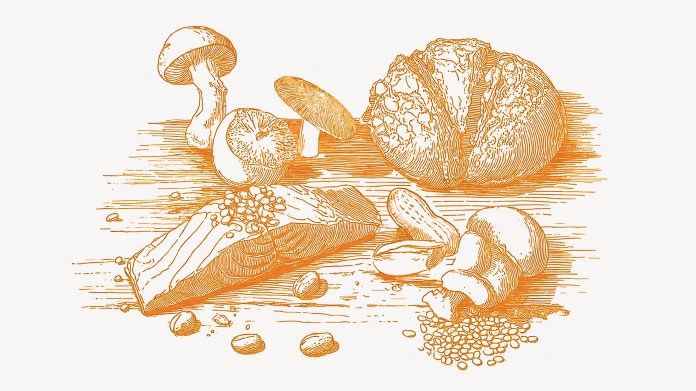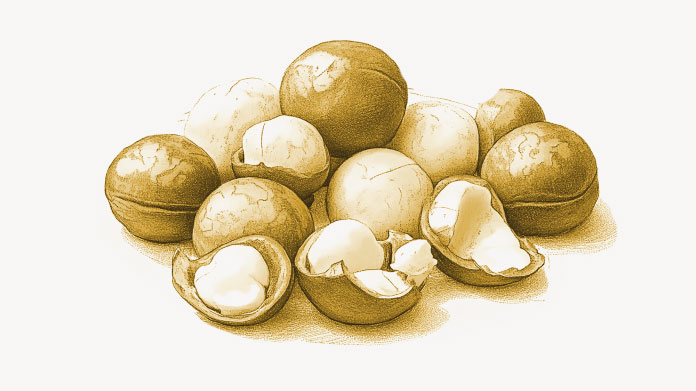Plant proteins: definition, sources, recipes and supplements
What are the best sources of plant proteins? Discover what non-animal products to eat, to ensure a good daily intake of protein.

The plant kingdom is packed with high-quality proteins
Like all living organisms, plants contain proteins. They fulfil in plants the same type of function as they do in animals: enzymatic (they catalyse reactions), structural, mobility, cell communication, etc.
It’s proteins, for example, which determine when trees shed their leaves and how plants defend themselves against attack, as well as facilitating absorption of nutrients essential to the growth of the plant or its fruit, etc. (1-3)
For anyone keen to increase their daily protein intake, or reduce their consumption of animal-source protein (for ethical or environmental reasons), it’s thus important to know which foods are high in plant proteins.
As a reminder, daily protein intake, depending on age, objectives and level of physical activity, should be between 0.8g per kilo of bodyweight and 2g per kilo of bodyweight (the latter when building muscle mass for example) (4).
The best dietary sources of plant proteins
Given that plant proteins play a fundamental role in the development, growth and death of plants, the highest amounts are usually found in seeds (with a few exceptions: spirulina, klamath algae, moringa leaves ...)
The best plant protein sources are: (5-8)
- spirulina, which contains 65g of protein per 100g and is particularly popular with vegetarians and vegans as a source of plant proteins. It’s usually consumed in tablet form, which is also good for energy and immunity (one option being the supplement Spirulina) ;
- Klamath blue-green algae (AFA), with 63g of protein per 100g and which importantly, is the only plant source of vitamin B12, making it invaluable for vegans. With a high content of PEA, it’s also popular for its positive effects on mood (it’s the substance in the supplement AFA Extract) ;
- soya, containing 36g per 100g, which can be consumed in the form of tofu and sprouted seeds, etc.;
- moringa, which contains 27g per 100g, but which is hard to find in Europe in the form of leaves for use in cooking. However, many people choose to consume it in supplement form to help control their blood sugar levels (Organic Moringa leaf extract, for example) ;
- hemp seeds, lentils, pumpkin seeds, peanuts, kidney beans, broad beans, split peas, chickpeas, etc. which contain between 20g and 26g of protein per 100g and which should really form the basis of a vegetarian diet rich in protein, fibre, minerals and trace-elements;
- oats, which contain an average 16g of protein per 100g and which offer the additional advantage of having a low glycaemic index whilst being very fortifying, making them the perfect choice for a vegan breakfast high in plant proteins;
- spelt and buckwheat, which contain between 13g and 15g of protein per 100g;
- quinoa, which contains 14g of protein per 100g;
The aim is to vary your plant protein sources over a week to create balanced meals from a variety of seeds, nuts, grains and pulses.
Vegetarian recipes to ensure a good intake of essential amino acids
Above all, however, we need to obtain specific amino acids from the protein we consume. Amino acids are actually the building blocks of proteins. While the body is able to produce 11 of them itself, 9 have to be obtained from the diet: tryptophan, lysine, methionine, phenylalanine, threonine, valine, leucine, isoleucine and histidine (9).
The problem is that these essential amino acids are not uniformly present in all plant proteins. That’s why it’s always best to combine cereals with pulses. Apart from being more digestible, this combination delivers a balanced intake of essential amino acids: the pulses offer amino acids not provided by the cereals, and vice versa.
Here are some very simple vegetarian or vegan combinations/recipes: rice (cereal) with lentils (pulses) ; corn (cereal) with kidney beans (pulses); oats (cereal) with soya (pulses)... all of which you can mix with sauteed pumpkin seeds or chopped peanuts (seeds), or sprinkle with chopped pistachios, almonds or walnuts (nuts).
Vegetarians, though not vegans, also have the option of taking a daily dose of whey protein, whey being a by-product of cheese production. Whey protein contains all the essential amino acids in sufficient quantities to meet the body’s needs (10).
References
- ROUTT, Sheri M. et BANKAITIS, Vytas A. Biological functions of phosphatidylinositol transfer proteins. Biochemistry and cell biology, 2004, vol. 82, no 1, p. 254-262.
- JAILLAIS, Yvon. Fonctions du rétromère dans le trafic de protéines, la polarité cellulaire et le développement d’Arabidopsis. 2007. Thèse de doctorat. Lyon, École normale supérieure (sciences).
- LANDRY, Jacques et HUOT, Jacques. Modulation of actin dynamics during stress and physiological stimulation by a signaling pathway involving p38 MAP kinase and heat-shock protein 27. Biochemistry and Cell Biology, 1995, vol. 73, no 9-10, p. 703-707.
- DEUTZ, Nicolaas EP, BAUER, Jürgen M., BARAZZONI, Rocco, et al.Protein intake and exercise for optimal muscle function with aging: recommendations from the ESPEN Expert Group. Clinical nutrition, 2014, vol. 33, no 6, p. 929-936.
- GUÉGUEN, Jacques, WALRAND, Stéphane, et BOURGEOIS, Oriane. Les protéines végétales: contexte et potentiels en alimentation humaine. Cahiers de Nutrition et de Diététique, 2016, vol. 51, no 4, p. 177-185.
- REMOND, Didier. Quelles spécificités et complémentarités nutritionnelles des aliments sources de protéines végétales et animales?. In : Journées Francophones de Nutrition. 2020.
- WALRAND, Stéphane, COXAM, Veronique, MORAND, Christine, et al.Rechercher les qualités nutritionnelles des protéines végétales. In : Les rencontres de l'Inra au salon de l'agriculture. 2013.
- CHARDIGNY, Jean-Michel. Les protéines végétales pour l’alimentation humaine.
- ROGERS, Quinton et LEUNG, P. MB. The influence of amino acids on the neuroregulation of food intake. In : Federation proceedings. 1973. p. 1709-1719.
- HA, Ewan et ZEMEL, Michael B. Functional properties of whey, whey components, and essential amino acids: mechanisms underlying health benefits for active people. The Journal of nutritional biochemistry, 2003, vol. 14, no 5, p. 251-258.
Keywords
5 Days
Good quality product and customer service.
So far, I'm liking this product, and the customer service was very good.
ELZL
12 Days
The products I use are excel·lent
The products I use are excel·lent
ROSAS Josep Maria
20 Days
Delivery is prompt and I never saw a…
Delivery is prompt and I never saw a quality problem with the manufacturing. It is not possible to assess efficacy on a personal basis, since too many factors come into play. Efficacy can only be assessed statistically with a sufficient number of cases.
Roger De Backer
21 Days
I collaborates with the Supersmart…
I collaborates with the Supersmart more than 10 years. Every thing is going good. Quality of the things is good. Delivery comes in time. Five stars definitely !!!
Oleksiy
21 Days
All good
Simple, frictionless site, easy ordering, good delivery updates and execution.
Chris Robbins
23 Days
I feel better
I feel better
Peter Ammann
23 Days
Prompt delivery
Prompt delivery
JAKUB Radisch
24 Days
My new go-to for top quality supplements!
I am buying more and more of my supplements from this superb, high quality company. Cannot recommend it enough. Plus, excellent customer service with a quick, helpful team and speedy deliveries. Highly recommend Supersmart!
Cecilie H.
28 Days
SUPERSMART WHAT ELSE👍
SUPERSMART WHAT ELSE👍
DIEDERLE Christophe
31 Days
Excellent quality products with…
Excellent quality products with innovative formulas, as someone who has been suffering with acid reflux, these supplements have been lifesavers.
Oriana Moniz
31 Days
high quality supplement!
high quality supplement!
GALANT
32 Days
Good service prompt delivery
Good service prompt delivery
Mrs Marcella Reeves
37 Days
I like your clear explanation
I like your clear explanation. And how to make a choice of products for a specific health problem
Ingrid
43 Days
Great product and it arrives quickly.
Great product and it arrives quickly.
SOMMARIVA Gianni
44 Days
Excellent products and fast service.
Excellent products and fast service. What do we need more?
Margarida



